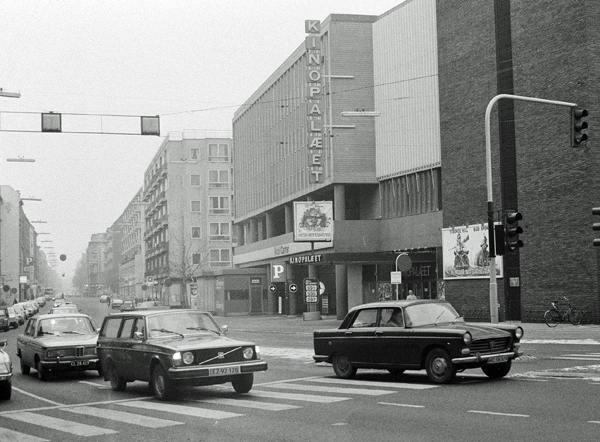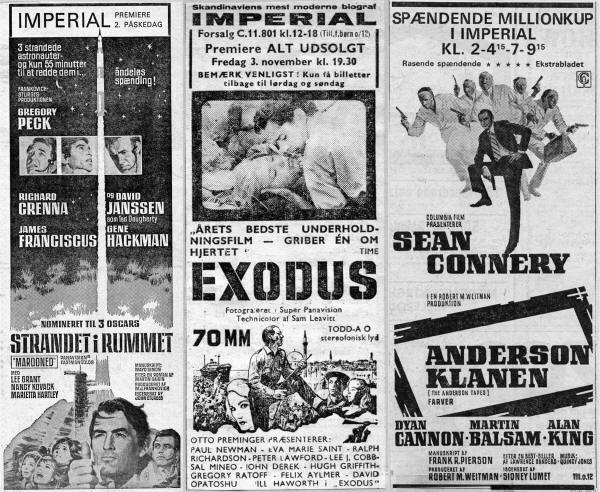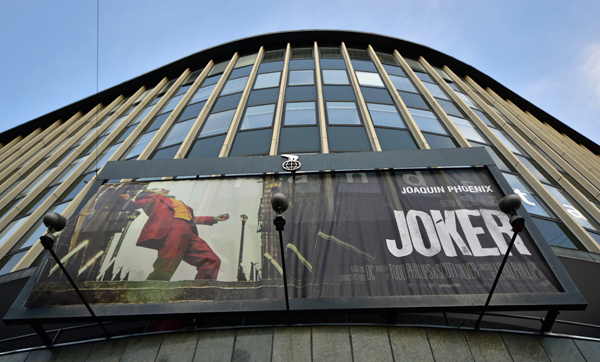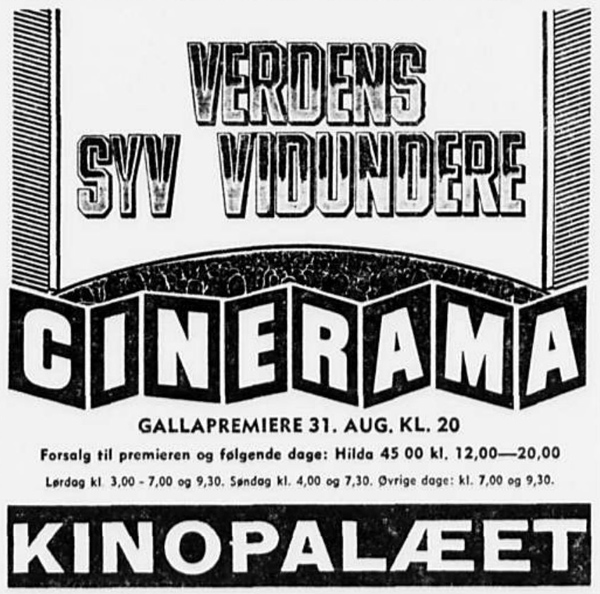3 Falke Bio, Kinopalæet and Imperial Bio
|
Read more at in70mm.com The 70mm Newsletter |
||||||
| Written by: Thomas Hauerslev. This article was first published in Cinema Technology, December 2002. Reprinted with permission from Jim Slater. | Date July, 22, 2003 | ||||||
|
The past 20+ years, many people have regarded one cinema in Copenhagen as the most luxurious cinema ever built in Denmark - The Imperial. Imperial Bio, still state-of-the-art, is the benchmark to which many cinemas are compared. The audience today are probably not aware that, 40 years ago, when the Imperial opened, there were actually several cinemas of similar standard. I recall seeing a re-run of "The Guns of Navarone" in 1973 (age 10) at Imperial and being VERY impressed by the grandeur and spectacle it had offer. A few years later I discovered its two siblings, the "3 Falke Bio" and the "Kinopalæet" and the trio became my favorite cinemas. Unfortunately, the siblings closed in the early 1980s. This is the story of a trilogy of cinemas, all purpose-built for 70mm with huge auditoriums and very wide screens. • Go to 70mm, Cinerama and Cinemiracle shown in Denmark • Go to 70mm Cinemas in Denmark and the first 70mm film In the 1950s, the municipal management of Frederiksberg, a borough inside Copenhagen, realized that the city was growing and a new City Hall would be needed. The demolition of the old building made way to build the "Falconercenter" - a modern hotel, concert, conference and cinema complex with shops and restaurants. The architect was Ole Hagen (1913 - 1984) and his work was revolutionary for its time. He built an 18-floor hotel with a 1200-person conference centre/music theatre and a 1000 seat cinema. The cinema became the 3 Falke Bio and it was the first cinema in Scandinavia built to Todd-AO specifications. At about the same time, also in Frederiksberg Ole Hagen was commissioned to build the 17 floor Codan Insurance Company high-rise. Behind this huge building, he planned the Kinopalæet with 1223 seats. Kinopalæet was rebuilt 2½ years later to accommodate 3-strip Cinerama which premiered there in 1962. In the city of Copenhagen, quite near to the Town Hall square, the Imperial complex took form in the late 1959. It was a massive building with a large 4-star hotel with 160+ rooms, offices, car park and a cinema. In the space of three years, 3 gigantic exclusively designed cinemas had been opened, and they were all built for 70mm with huge curved screens. Imperial was reviewed in several magazines including the article "Imperial Bio - Design for Copenhagen" (IDEAL KINEMA, April 12, 1962) where it was described it as "The most modern and best designed cinema in Europe". 3 Falke Bio was awarded a bronze plaque by the "Committee for awarding good and beautiful buildings in Frederiksberg" November 1, 1961. It was Danish design at it's very best. |
More in 70mm reading: 70mm Cinemas and Film in Denmark PDF: Three Great Danish 70mm Cinemas Imperial Bio - Design for Copenhagen Imperial Bio, Copenhagen, Denmark 3 Falke Bio, Copenhagen, Denmark - The First Todd-AO Theatre in Scandinavia Kinopalæet Super Cinerama in Denmark |
||||||
Box Office and Foyer Areas |
|||||||
 The
Kinopalæet on Gammel Kongevej in December 1979. Picture: Thomas Hauerslev The
Kinopalæet on Gammel Kongevej in December 1979. Picture: Thomas HauerslevThe Imperial and Kinopalæet box offices were located nearly on the sidewalk whereas 3 Falke Bio, not even on the main road, was "hidden away" in a courtyard, sharing the taxi kiss-and-ride entrance with the hotel and concert venue. For years 3 Falke's audience complained about standing outside in the rain and snow buying their tickets. The problem wasn't solved until 1986, 4 years after the closure, fortunately when the entire courtyard was covered with a glass roof. Additionally the 3 Falke Bio foyer was quite small and in fact not designed for 1000 guests. It was a major design error and it plagued the cinema for years during intermissions. Kinopalæet and Imperial offered the audience the comfort of air conditioned indoor ticket sale. At Imperial the customer proceeded inside the high-ceiling main vestibule and met a huge 24 carat gold wall, film poster displays, a kiosk/sweetshop and restrooms. From the lower vestibule a very wide marble staircase let the audience upstairs to the upper foyer and the bar. The cinema was on top of the whole foyer. At Kinopalæet after showing your ticket in the vestibule a staircase would guide you two floors up to the main foyer with a bar, restrooms, and the kiosk/sweetshop. The stairs and foyer floor was carpeted unlike the Imperial (marble) and the 3 Falke (Linoleum). The foyer was considerably larger than 3 Falke's when it was apparent how troublesome a small foyer could be. Walls were covered in oak or teak wooden panels. In the far end a spiral staircase let upstairs to projection, which was right on top of the foyer. Two wide doors let the audience into the theatre. There were cloakrooms at Imperial and 3 Falke Bio, but I cannot recall any at Kinopalæet. There probably were, but had possibly been discontinued by the time I started to seeing films there. |
|||||||
The Auditoria |
|||||||
 Vintage
newspaper adverts from bygone days, when adverts design actually made you
want to go and see the film. Vintage
newspaper adverts from bygone days, when adverts design actually made you
want to go and see the film.Although all three cinemas were big and spectacular they were quite different from each other. The 3 Falke Bio and Kinopalæet, designed by the same architect, were both intimate, due to the dark color scheme used in the foyer and cinema. The Imperial never had this feeling of intimacy because of the use of marble, steel and a brighter color scheme. And with 1521 seats, Imperial was considerably larger than 3 Falke Bio and Kinopalæet. Seating in Imperial was fan shaped on a floor, which sloped up towards the projection room. The original seats were specifically designed for Imperial and stayed until 1987 when French Quinette seats were brought in. In 1998 new specifically designed Norwegian Skeie "Imperial" seats were installed. All seats have remained red throughout the years though the number of seats declined because the seats were made larger. When I was young I always sat in the last row enjoying this "ocean of chairs" in front of me with the screen in the background. In later years I preferred moving towards the middle of the cinema to get a "wrap around" feeling from the screen. The only flaw of Imperial was perhaps the screen, which is always viewed up from the floor, i.e., you look upwards. Seating in 3 Falke bio remained more or less unchanged for all 24 years. The layout was 11 rows on the floor with a easy slope. The remaining 17 rows were on a terrace which sloped quickly up towards projection level. Sitting on row 12 or 13 the view to the screen was absolutely fantastic as you were looking straight into it. Sitting in front of the massive Todd-AO screen was spectacular to say the least. I never got the same feeling of being "in the picture" at Kinopalæet or Imperial. Kinopalæet originally had 1223 seats, but that number was reduced during it's Cinerama days in 1962/63 to around a 1000 seats. In 1972 the layout was again changed to 976 extremely comfortable specially designed chairs. By far the best chair I've ever sat in. I even have 4 of those chairs at home, using one of them in my home cinema. In short, 3 Falke Bio had the best view to the screen, the best seats were at Kinopalæet and the most grandiose experience was at Imperial. |
|||||||
Projection Equipment |
|||||||
 From
the nostalgic to present day. "Joker" in 70mm at the Imperial Bio in 2019.
Picture: Thomas Hauerslev From
the nostalgic to present day. "Joker" in 70mm at the Imperial Bio in 2019.
Picture: Thomas HauerslevAll three cinemas had a pair of DP70s installed. Kinopalæet started out with the Bauer U2 which they later dropped in favour of the Philips masterpiece. Apparently the management wasn't satisfied with the Bauer equipment and wanted the DP70 instead. Kinopalæet also had a love affair with 3-strip Cinerama and the Century machines. 3 Falke Bio and Imperial were also equipped with a Philips FP56 for adverts and trailers. The Imperial even had a fourth projector, a Leitz 16mm. The Leitz machine stayed until 1998 and was used less than a 100 hours. Bauer Co. also tried to sell U2s to Imperial, but the DP70 was chosen instead. The 70mm projection lenses of 3 Falke were the American Optical Cine Apergon Todd-AO lenses. A fabulous set of lenses, which stayed with the cinema until closure. ISCO's lenses were installed at Kinopalæet and Imperial. When Kinopalæet discontinued 3-strip Cinerama (1963), a pair of the massive ISCO 87,5mm T-Kiptagons with a magnifier were installed to project 70mm on the Cinerama screen. A regular set of 100mm ISCO lenses were used at Imperial until 1992, when a new set of ISCO's 99mm Ultra Star lenses were brought in. Around 1975 a Kinoton ST270 was installed at 3 Falke. The non rewind system never became particular popular and was ultimately removed. The platter is still in use, however, but now at the Palads, #9. Imperial also got platters in 1987. All three cinemas originally had 5 sound channels behind the screen and numerous surround speakers. New amplifiers and speakers for 35mm Dolby optical stereo sound were introduced during 1979 in all three cinemas. In 1987, when a CP200 and 70mm Dolby was installed at Imperial, however, it was reconfigured for 3 stage channels. And in 1998 all 5 stage channels came back, being installed for SDDS. Since 1979, JBL speakers have been at Imperial making it the largest JBL cinema installation in Denmark. |
|||||||
Repertoire |
|||||||
 Kinopalæet
was the only 3-strip CINERAMA cinema in Denmark. Opened with "Seven Wonders
of the World", 31. August 1962 Kinopalæet
was the only 3-strip CINERAMA cinema in Denmark. Opened with "Seven Wonders
of the World", 31. August 1962"South Pacific" was the opening movie at the 3 Falke. Todd-AO made quite an impact in those days and 782.710 people saw the film in 201 weeks. It was THE 70mm house of Denmark and even hosted a couple of 70mm premieres for all Europe ("Where Eagles Dare" and "Gone With the Wind"). During the first 9 years 3 Falke premiered around 20 films (12 in 70mm). 92% of the BO return came from the 70mm films! The seventies proved to be more difficult and films changed very often, compared to the previous decade. Only 6 films stayed on 3 Falke Bio´s vast canvas for more than 3 months from 1970 until closure in 1982. "The Godfather" (9 months), "The Great Gatsby" (5 months), "Hello, Dolly!", "Kelly's Heroes" and "Earthquake" (all 4 months), "Close Encounters of the Third Kind" (3 months). Kinopalæet opened with a Danish comedy, "Far til 4 på Bornholm" in 35mm mono. The owner of the cinema was ASA Film Studios, and they made the obvious choice and opened with their latest product. A handful of Cinerama films were shown on the huge 29 meter curve. Cinerama was a disaster in Denmark and it stayed only for 14 months. With the exception of "2001:a space odyssey" (premiered at the Rialto on an almost flat screen) 70mm films were obviously premiered at Kinopalæet "in Cinerama". Like the 3 Falke Bio, the 1970s proved to be difficult for a large cinema like the Kinopalæet. There were many successes like "What's up Doc?" and films starring the likes of James Bond, Clint Eastwood and Charles Bronson. Even Sensurround was installed for "Rollercoaster". During the summer of 1976, '78, '79 and '80, a cavalcade of all James Bond movies were shown (a new film every week) and during the summer of 1972 (16. June - 13. August)) a "Cavalcade of Giants" was shown before the louvered screen was removed. That included whatever was available of the old classic 70mm films. 22 of the most popular film from Kinopalæet's repertoire - mostly in 70mm. A new film every third day. But despite a very expensive refurbishment in 1972, Kinopalæet's days were numbered. Imperial Bio opened with "Exodus" in 70mm which stayed less than two months making it only a modest success. The cinema has done remarkably well during the past 40 years, the audience appreciates the Imperial, and so the rumor goes some attend no matter what film is shown! The cinema has been the premiere venue for nearly 25 years. I think the turning point came with "Star Wars" December 26 ,1977. It played for 4 months. Since then many of the biggest Hollywood productions have opened here and quite often celebrity guests have visited. Two of the longest runs were "Out of Africa" (9 months) in 1986 and "Titanic" (for 11 weeks) in 1998. Imperial was about to be rebuilt into 5 screen in the summer of 1983, but the plans never materialized as Nordisk Film bought the Sandberg Group. The takeover put an end to rebuilding plans. Nordisk Film quickly realized the potential of Imperial, and spent a lot of money for new sound, seats and maintenance through the 1980s and 90s. Just about every possible piece of 70mm and 35mm sound and projection equipment has been installed. |
|
||||||
Epilogue |
|||||||
 More than 100 cinemas have opened and closed in Copenhagen during the past 100 years. Much as I like this trio of cinemas, there are 97 other stories to be told.
To this day only the Imperial Bio has survived, but perhaps this situation could have been different. As early as 1971/2, there were plans to rebuild Kinopalæet into three screens. Two "art" cinemas were supposed to have been built in the rear of the cinema, retaining the large screen, but the plans were never executed. It's my firm belief that if Kinopalæet was rebuilt, it would probably never have closed. In the fall of 2001 the building was demolished after 20 years extra service as an office block. The rubble was reused as support for new roads. Just think of it; you could be driving on the remains of Kinopalæet. More than 100 cinemas have opened and closed in Copenhagen during the past 100 years. Much as I like this trio of cinemas, there are 97 other stories to be told.
To this day only the Imperial Bio has survived, but perhaps this situation could have been different. As early as 1971/2, there were plans to rebuild Kinopalæet into three screens. Two "art" cinemas were supposed to have been built in the rear of the cinema, retaining the large screen, but the plans were never executed. It's my firm belief that if Kinopalæet was rebuilt, it would probably never have closed. In the fall of 2001 the building was demolished after 20 years extra service as an office block. The rubble was reused as support for new roads. Just think of it; you could be driving on the remains of Kinopalæet.3 Falke Bio closed because of mismanagement, terrible programming, lack of distributor support and ultimately lack of audience. The closure was a real shame but the auditorium itself has survived (with little change) for 20 odd years as a concert venue. I feel fortunate that I was trained as a projectionist at 3 Falke and took pictures 20 years ago. A few years later I also ran films at the Imperial for some 7 years. It was a privilege; a great "toy" and I had a ball. Being born in 1963, I never experienced the heydays of 70mm when first run films were "always" presented in 6-track magnetic stereo on big curved screens. I can get the feeling, however, with this interest for the three big 70mm cinemas of Copenhagen. It's sad to see modern "design" of cinemas when I compare it with what they could do 40-50 years ago. Many contemporary cinemas look cheap to me, oversized cardboard boxes thrown up in a hurry with a shovel and a hammer. For me 3 Falke, Kinopalæet and Imperial are truly unique, and designers could learn a great deal by looking back in time. Sadly, most of our Danish cinema heritage has been rebuilt or demolished in the name of progress. Imperial is one of the very few remaining original cinemas from an era (nearly) gone with the wind. |
|||||||
70mm and Cinerama Premieres |
|||||||
|
|||||||
|
Go: back
- top - back issues Updated 22-01-25 |
|
